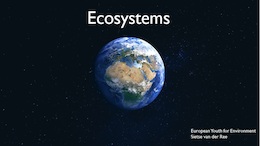Toolbox — For Training and Youth Work
All new tools in your inbox: Be the first to know about new tools for learning with our e-mail notifications.
Simulation Exercise
Ecosystems workshop
This workshop makes participants aware of factors that influence nature, what food webs are and which processes play important roles in ecosystems. Participants work together and will acquire social skills together with knowledge about entrepreneurship.
Aims of the tool
This workshop aims to increase more awareness of the importance of good balanced ecosystems, working together and entrepreneurship.
Description of the tool
Description of the workshop
The workshop starts with a presentation of 30 minutes about ecosystems and food webs. This presentation can be found in a separate file and is called ‘Ecosystems’. The presentation contains examples of real-life systems, how to keep them healthy and how they can be influenced. A video is shown about Yellowstone national park to show the participants how an ecosystem can change dramatically due to cascade effects in the food web.
Link: https://www.youtube.com/watch?v=ysa5OBhXz-Q
The presentation also contains this video and the explanation of the workshop and the rules.
After the presentation the participants are placed into groups of 8 people and every group gets a green A2 paper. The groups can then cut out the pictures and place them on the green A2 paper. There are also grey and blue A2 papers available for cutting, serving as rocks and water. As said, there are rules:
• The green paper is the basis of the ecosystem
• Grey paper is rock
• Blue paper is water
• Min. 15 pictures of animals and/or plants per ecosystem!
• Max. 25 pictures of animals and/or plants per ecosystem!
• 1 predator picture is 5 predators.
• 1 prey picture is 10 prey animals.
• For bacteria, O2, N2 & CO2 one picture is enough.
• Make a balanced ecosystem. Later on you have to justify your choices!
• Tip! Generally: more diverse means more stable!
• Fun! Give your ecosystem a name!
The building of the ecosystem will take about 1,5-2 hours.
After the building process, the ecosystems will be reviewed. The whole group together with the trainer will discuss if the systems can be stable.
After discussing, major disasters will happen to the ecosystems of the groups. These disasters are kept secret for the participants, until now! After every disaster a trainer will discuss the consequences for the ecosystems with the whole group. The disasters are:
- Bush fires: all the plants will disappear.
- A virus will kill all the herbivores/prey animals
- A road will be constructed through the middle of the ecosystem. (Animals cannot cross this road).
- Flash floods. The rivers, lakes and/or sees will overflow.
- Nitrogen levels increase dramatically due to agricultural activities.
- A city will be build in the right upper corner of your ecosystem.
- Add one species to your ecosystem that will bring the system out of balance. It does not have to be a species from the pictures.
Other ideas:
- Industrialization. CO2 level rises.
- A lot of ash in the air due to vulcanism.
- Companies will dump an excess of plastic waste in your ecosystem.
The disasters can be seen on the PowerPoint slides.
Evaluation
After the disasters and discussions the trainer will evaluate the workshop. Questions for the participants can be:
- Could you have built your ecosystem in a different and better way, so the consequences from the disasters were less severe?
- Is it a good idea to connect all the ecosystems that are made by the groups? Why?
To conclude the trainer can say:
- It is important to learn about these ecosystems, because these systems make the world we live in.
- We influence these systems, but it influences us as well in our daily lives. Think of food, energy, pets, safety.
- What needs to be done is the opposite of the disasters we looked at. Like connecting ecosystems, avoidance of nitrification, do not add exotic species and use green energy.
End product
The end product will be an ecosystem on a green A2 paper by placing pictures of different kinds of organisms on it. The pictures that can be used for this workshop are found in the appendix and represent predators/carnivores, predators/herbivores, insects, plants, bacteria, nitrogen, oxygen and carbon dioxide. The participants can decide how their ecosystem looks like in detail. But they will need to justify their choices about the composition of pictures.
As a trainer background information about food webs and ecosystems is required. This does not count for the participants.
Available downloads:
Disclaimer
SALTO cannot be held responsible for the inappropriate use of these training tools. Always adapt training tools to your aims, context, target group and to your own skills! These tools have been used in a variety of formats and situations. Please notify SALTO should you know about the origin of or copyright on this tool.
Tool overview

http://toolbox.salto-youth.net/2867
This tool is for
Age 15+
and addresses
Environment
It is recommended for use in:
Youth Exchanges
Training and Networking
Materials needed:
• The green paper is the basis of the ecosystem
• Grey paper is rock
• Blue paper is water
• Pictures of animals and/or plants.
• Predator- and prey pictures.
• Bacteria-, O2, N2 & CO2 pictures.
https://www.youtube.com/watch?v=ysa5OBhXz-Q
Duration:
3 hours
Behind the tool
The tool was created by
Sietse van der Ree
in the context of
European Youth for Environment (E.Y.E.)
The tool has been experimented in
Youth Ecxhange
The tool was published to the Toolbox by
Ina van de Vendel (on 27 August 2020)
and last modified
19 May 2020
Comments
No comments have been posted yet.
If you want to comment on this tool, you need to be signed in with your MySALTO account. Sign in now